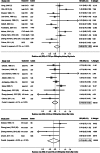Circulating and dietary magnesium and risk of cardiovascular disease: a systematic review and meta-analysis of prospective studies
- PMID: 23719551
- PMCID: PMC3683817
- DOI: 10.3945/ajcn.112.053132
Circulating and dietary magnesium and risk of cardiovascular disease: a systematic review and meta-analysis of prospective studies
Abstract
Background: Clinical hypomagnesemia and experimental restriction of dietary magnesium increase cardiac arrhythmias. However, whether or not circulating or dietary magnesium at usual concentrations or intakes influences the risk of cardiovascular disease (CVD), including fatal ischemic heart disease (IHD), is unclear.
Objective: We performed a systematic review and meta-analysis to investigate prospective associations of circulating and dietary magnesium with incidence of CVD, IHD, and fatal IHD.
Design: Multiple literature databases were systematically searched without language restriction through May 2012. Inclusion decisions and data extraction were performed in duplicate. Linear dose-response associations were assessed by using random-effects meta-regression. Potential nonlinear associations were evaluated by using restricted cubic splines.
Results: Of 2303 articles, 16 studies met the eligibility criteria; these studies comprised 313,041 individuals and 11,995 CVD, 7534 IHD, and 2686 fatal IHD events. Circulating magnesium (per 0.2 mmol/L increment) was associated with a 30% lower risk of CVD (RR: 0.70; 95% CI: 0.56, 0.88 per 0.2 mmol/L) and trends toward lower risks of IHD (RR: 0.83; 95% CI: 0.75, 1.05) and fatal IHD (RR: 0.61; 95% CI: 0.37, 1.00). Dietary magnesium (per 200-mg/d increment) was not significantly associated with CVD (RR: 0.89; 95% CI: 0.75, 1.05) but was associated with a 22% lower risk of IHD (RR: 0.78; 95% CI: 0.67, 0.92). The association of dietary magnesium with fatal IHD was nonlinear (P < 0.001), with an inverse association observed up to a threshold of ∼250 mg/d (RR: 0.73; 95% CI: 0.62, 0.86), compared with lower intakes.
Conclusion: Circulating and dietary magnesium are inversely associated with CVD risk, which supports the need for clinical trials to evaluate the potential role of magnesium in the prevention of CVD and IHD.
Figures




Comment in
-
Circulating magnesium and cardiovascular events.Am J Clin Nutr. 2014 Mar;99(3):647-8. doi: 10.3945/ajcn.113.077313. Am J Clin Nutr. 2014. PMID: 24557532 No abstract available.
References
-
- Shechter M. Magnesium and cardiovascular system. Magnes Res 2010;23:60–72. - PubMed
-
- Mubagwa K, Gwanyanya A, Zakharov S, Macianskiene R. Regulation of cation channels in cardiac and smooth muscle cells by intracellular magnesium. Arch Biochem Biophys 2007;458:73–89. - PubMed
-
- AHA (ECC Guidelines). Guidelines for cardiopulmonary resuscitation and emergency cardiovascular care, Part 8: Advanced challenges in resuscitation: Section 1: Life-threatening electrolyte abnormalities. Circulation 2000;102:I217–22. - PubMed
-
- Klevay LM, Milne DB. Low dietary magnesium increases supraventricular ectopy. Am J Clin Nutr 2002;75:550–4. - PubMed
-
- Nielsen FH, Milne DB, Klevay LM, Gallagher S, Johnson L. Dietary magnesium deficiency induces heart rhythm changes, impairs glucose tolerance, and decreases serum cholesterol in postmenopausal women. J Am Coll Nutr 2007;26:121–32. - PubMed
Publication types
MeSH terms
Substances
Grants and funding
LinkOut - more resources
Full Text Sources
Other Literature Sources
Miscellaneous

